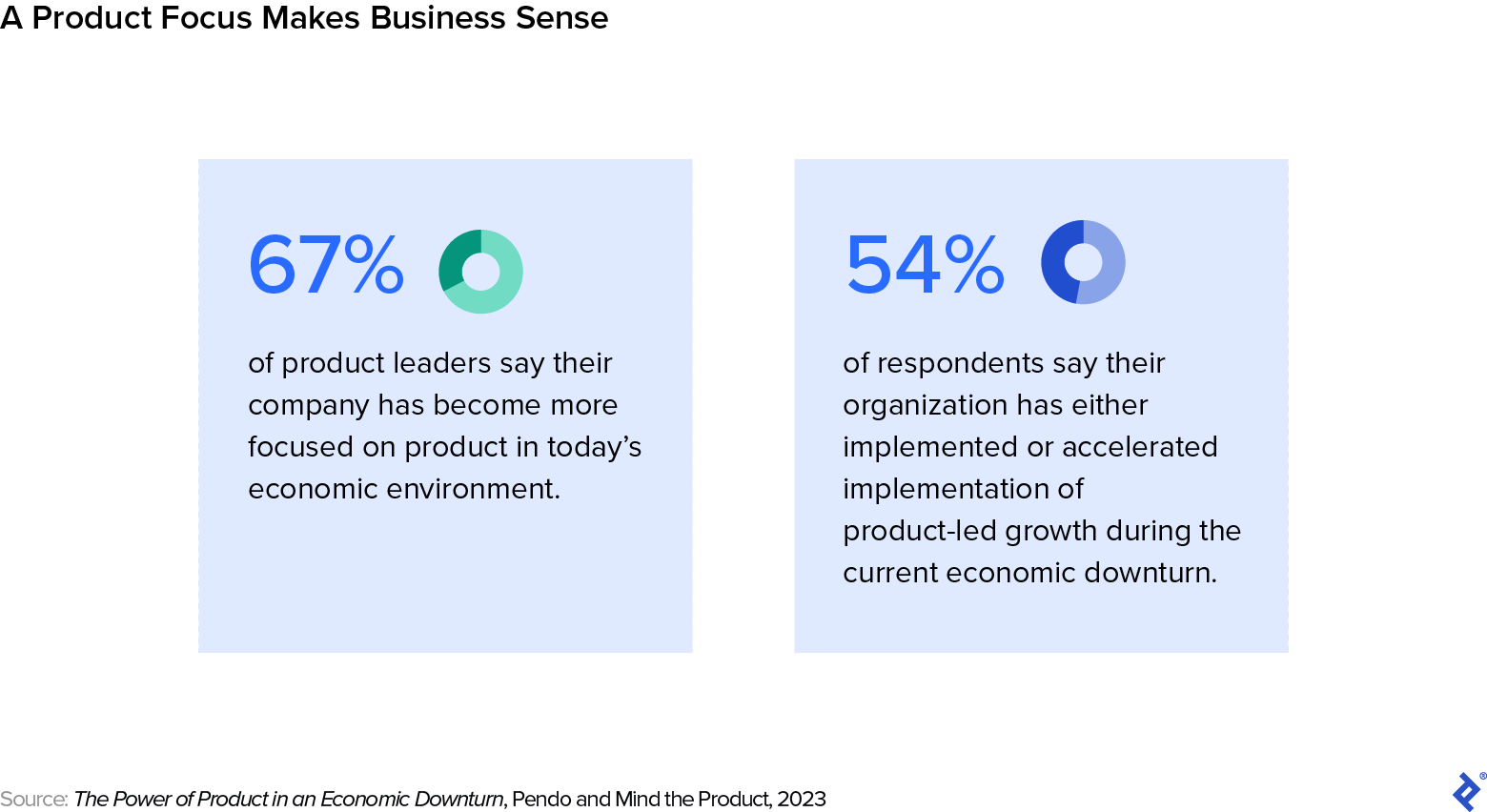Drive Commercial Success With a Product-led Growth Culture
Aligned teams create a seamless customer experience. Unlock the potential of product-led growth in your organization with these six tips.
Aligned teams create a seamless customer experience. Unlock the potential of product-led growth in your organization with these six tips.
Philippe is a growth product manager, Agile expert, and digital innovation consultant. Over the past 15 years he has helped clients such as Fujitsu and Michelin develop engaging products and transform their businesses to be more customer-centric.
Previous Role
Product DirectorPREVIOUSLY AT


If you’ve ever sampled a product in a supermarket or downloaded the free version of an app, and then later returned to purchase it, you’ve experienced product-led growth. Product-led growth strategies are used by businesses all around us, including Netflix, Slack, Dropbox, Jira, and even Coca-Cola.
Product-led growth strategies use the customer experience as the driving force for continuous acquisition, engagement, and retention. As an alternative to traditional sales-led strategies, this approach makes the product the primary means of attracting and keeping customers. The result is a product-centric customer journey, characterized by self-service, fast onboarding, an intuitive experience, and high levels of satisfaction.
The rapid adoption of product-led growth in recent years has been driven primarily by the expansion of apps and other digital products, while customers have simultaneously become more aware and empowered by the availability of information online. This access has changed how customers research and evaluate a product before making a purchase. They now often have more control over the types of interactions they have with brands, the tools and resources to make an informed decision, and the autonomy to make purchases themselves through the products. The growth of digital channels also means that customers are likely to have multiple experiences with your brand or product without your involvement.
Customer expectations have evolved too. Customers want seamless, convenient, and enjoyable product experiences. They want to be able to try, purchase, and receive support all through the same platform. Interactions with companies now take a different form, with increased value placed on transparency and authenticity. The online presence of a brand and the way it engages with customers are important factors in customer decision-making.
These changing customer behaviors and purchasing patterns mean that adopting a product-led growth strategy can be extremely effective in driving commercial success. Many companies have also realized that a product-led strategy makes more economic sense, as it lowers advertising costs and doesn’t require large sales teams. In fact, two-thirds of product leaders report that their companies have become more focused on product in today’s economic environment, according to a 2023 survey by Pendo and Mind the Product. More than half of respondents say their organizations have either implemented or accelerated implementation of product-led growth during the current economic downturn.
It’s not enough, though, to simply create a seamless customer experience; a product-led growth strategy must be embedded in every aspect of an organization. This can require a huge cultural shift. As an experienced growth product manager and digital transformation consultant, I have worked with many businesses to change mindsets, implement new processes, and align teams toward new company objectives. It is a challenging but worthwhile undertaking—the six tips I suggest here will help you get started.
The Benefits of Product-led Growth
The process can be challenging, but a successful product-led growth transformation brings companies numerous benefits:
- Customer acquisition: A great product experience is a powerful way to attract and acquire new customers.
- Viral growth: Satisfied customers will become promoters of your product and brand, leading to organic and word-of-mouth growth.
- Lower customer acquisition cost: The cost of acquiring customers can be reduced compared to traditional promotional efforts.
- Better product-market fit: The product-led growth framework uses a data-driven, Agile product development process, improving market fit and customer experience.
- Customer engagement: A focus on a seamless and intuitive product experience leads to increased customer satisfaction and engagement, which can then help improve other aspects of the acquisition funnel.
In addition to these significant commercial benefits, companies adopting a product-led growth strategy can also see improved alignment and engagement among their internal teams toward a common vision and goal.
Overcoming the Myths of Product-led Growth
Despite the many advantages of adopting a product-led growth strategy, there are a couple of pervasive myths that leaders commonly cite as reasons to resist adoption.
It is widely believed that a product-led growth strategy will be led by a product manager. With a product-led growth culture, however, product managers are not the only ones responsible for the product’s success; other departments play a significant role. Yes, the product manager takes the lead on creating an exceptional user experience and executing the product strategy. But all teams—including others in marketing, sales, billing, and support—must commit to the vision and ensure that all processes are integrated, so that they serve the customer without friction.
Being product-led can make functions more effective. Marketing, for example, can use product data to make its efforts more focused and create more targeted campaigns. Sales can benefit from higher-quality leads identified by the product data.
Many B2B companies think that a product-led growth strategy won’t work for them, but as long as there is good product-market fit, the approach will work for B2B organizations just as well as it does for B2C. Companies like Twilio, Atlassian, and AWS are examples of successful B2B product-led enterprises. Their products bring in leads, which are then converted into large-scale deals. A commonly used tactic in the B2B industry is the land and expand strategy, in which companies acquire small contracts through freemiums or free trials, which eventually expand into other departments or business units.
Product-led growth is just one of many strategies available for companies. Depending on the product and market, companies may need to integrate multiple approaches or start by adopting product-led growth tactics in select areas. Sometimes sales-led growth may simply be more appropriate if, for example, you need a quicker path to profitability or it’s beneficial to tailor your sales pitch to each customer. The best strategy for each company will depend on the product, market, price, and means of distribution.
What Is a Product-led Growth Culture?
A product-led growth culture means that every department across the organization is centered on the product. Here are some of the ways it differs from traditional business strategies:
- The product experience is the priority, with sales and promotional efforts coming second.
- All decisions are driven by data. Product usage, retention, referrals, and engagement are the most important metrics.
- Growth is driven by organic usage and word-of-mouth: Your customers are now your best advocates. Product-led companies aim to turn customers into promoters.
The ideal organization is customer-centric and focuses heavily on product-market fit. Close alignment between what customers want and the value the product provides them is key to creating a product that customers will seek out, use, and pay for. To create alignment, organizations need a deep understanding of the needs and pain points of their target market, which is acquired through continuous experimentation and feedback collection.
6 Steps to Product-led Growth
Implementing a product-led growth culture takes time. It requires a huge shift in mindset for both leadership and employees, and the embedding of new processes at a foundational level. It is, in essence, a profound transformation across the organization. Don’t let this deter you from making the transition, though. Follow these six steps to get started:
Define the Vision
Develop a clear definition of what product-led growth means for your company and ensure that everyone understands the importance of the product experience. Conduct market research to ensure the market is big enough for scalability, establish what good product-market fit looks like, and evaluate your products to ensure they meet a real customer need.
Unite Everyone Behind a Common Goal
Achieving product-led growth is dependent on the contribution of many different departments and stakeholders. Align everyone across the company toward one North Star. Sales, marketing, product, finance, and customer support must each understand the role they play in product-led growth and be able to collaborate with one another, breaking the tradition of siloed functions. Changing ownership, responsibilities, and expectations can be difficult to manage—clearly communicate these changes to employees and other key stakeholders, and outline how success will be measured going forward.
Focus on the Customer
As product-led growth is centered on providing an outstanding experience, listen to what customers have to say. Feedback and requests should be integrated into product development and other processes across the organization. Find ways to deliver value early in the customer journey with your product. Ensure that the roadmap reflects customer priorities, delivering features that customers actually want.
Become Truly Data-driven
Your product can deliver a wealth of insights into your customers, so utilize them. Put data and analytics at the heart of every product and business decision. Track the customer journey across the product life cycle, from brand awareness to product usage and beyond, with the goal of improving the customer’s experience of the sales funnel. Invest in software such as Pendo or Amplitude to do this. You should monitor different product-led growth metrics at each stage of the journey:
Stages of the Customer Life Cycle | Metrics to Track |
|---|---|
Awareness |
|
Consideration |
|
Conversion |
|
Retention |
|
Advocacy |
|
Embrace Failure and Experimentation
Encourage teams to test new ideas and approaches and continuously iterate to improve the customer experience. Use an experimentation platform such as Optimizely to conduct A/B tests and monitor the results.
Transform at the Top
Leaders should promote the product-led growth culture by adopting the mindset themselves. Take risks, get obsessed with the customer, use data to guide business decisions, and embed experimentation into the company culture—and consider hiring a growth product manager to lead on these initiatives.
Product-led Growth Is an Organization-wide Effort
Implementing a culture that embraces and drives product-led growth requires systemic change across an organization, which can only be accomplished through consistent transparency and communication. This transition may make people uncomfortable at first, so lead by example, clearly articulate goals and expectations, and ensure every team knows it is vital in creating a culture that drives commercial success.
Further Reading on the Toptal Blog:
Understanding the basics
What is product-led growth?
Product-led growth is a business strategy that uses the customer experience as the primary means of engagement, acquisition, retention, and referral. Decisions are driven by data, and growth is driven by organic usage and word-of-mouth.
What does it mean to be a product-led growth business?
A product-led growth business aligns all functions across a company with the goal of creating a seamless user experience. Marketing and sales teams will augment traditional tactics by leveraging product data to focus their efforts.
How does the product-led growth model work?
The product-led growth model works by allowing the customer to experience the value of the product for free before they make a purchase. The model provides the user with greater knowledge, transparency, and autonomy, leading to higher customer satisfaction.
London, United Kingdom
Member since November 5, 2020
About the author
Philippe is a growth product manager, Agile expert, and digital innovation consultant. Over the past 15 years he has helped clients such as Fujitsu and Michelin develop engaging products and transform their businesses to be more customer-centric.
Previous Role
Product DirectorPREVIOUSLY AT




